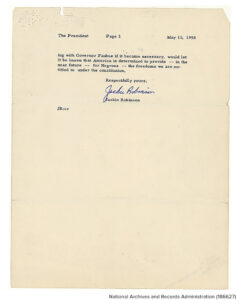
Celebrating Jackie Robinson
![Eleanor Roosevelt and Jackie Robinson at the Manhattan School for Boys, 06/16/1959. National Archives and Records Administration [NLR-PHOCO-A-6024(3)]. MHE World.](https://mhebtw.mheducation.com/wp-content/uploads/2016/04/042116_02P_IS.jpg)
In addition to the national recognition of Robinson’s anniversary, the city of Philadelphia recently passed City Council resolution officially apologizing for its behavior toward the legend. When the Dodgers played there, Phillies manager and players had taunted Robinson with racial slurs and he was refused service because of the color of his skin. Many consider it to be the most hostile treatment he received during a very turbulent career. The incident caused a backlash against the Phillies and helped to cultivate support among sympathetic commentators and fans. The apology was presented to Robinson’s widow, Rachel (he died in 1972 at the age of 53).
Dig Deeper Watch clips (or the whole film) of “42,” a feature film about the career of Jackie Robinson, from the time of his signing in 1945, to his historic rookie season. Write a paragraph about something that appeals to you and why.
The Tiny House Movement
The 1980s and 1990s ushered in an era of the sprawling McMansion. These were characterized as mass-produced, high-square-footage homes typically located in the suburbs. It is no surprise that a post-Recession, environmentally conscious era would encourage consumers in the other direction. The Tiny House Movement is made up of homes (and sometimes spaces) around 300 square feet (the typical American home is 2,600 square feet). They are usually thoughtfully designed to make the best use of space and still retain an element of charm.
In areas like New York City, the motivation to live in a small place can be space and expense. But others, who are not otherwise tied to such considerations, are drawn to tiny houses/spaces for a number of different reasons. For some, it is a way to live simplify living and to reduce the impact on the environment. The average cost to build a tiny house is $23,000. One of the biggest challenges to those who wish to own a Tiny House are zoning regulations, which often specify a minimum size for new construction on a lot, and disapproval from neighbors with concerns about property values.
What Do You Think? Would you consider living in a tiny house? Why or why not?
Breakthrough in Limb Reanimation
A surgical team at The Ohio State University Medical Center in Columbus, Ohio has successfully performed the first-ever documented case of limb reanimation. This complex procedure helped a paralyzed man regain control of his hand. The patient, 24-year-old Ian Burkhart, had suffered partial paralysis from a diving accident four years ago. Two years later, doctors isolated the part of the brain that controls hand movements and implanted a computer chip the size of an eraser head into Burkhart’s brain. Then he underwent intensive rehabilitation for several months, eventually learning to perform a series of tasks that involved picking up a bottle, pouring out its contents and using a straw to stir.
The results were published in a journal called Nature. The new technology is not being considered a “cure” for paralysis because restored function has only been possible so far inside of a laboratory. But the field of “neural engineering” is a rapidly growing one. Battelle Institute, also located in Columbus, Ohio, worked closely with OSU to develop the medical devices used to fire electronic patterns that could be picked up by the chip and run through a cable from a computer to Burkhart’s skull.
What Do You Think? Do you know of anyone who has lost bodily function due to a brain injury? What challenges do they face? What advancements (if any) have any been a part of? If you do not know anyone personally, do some research into a personal story of someone and record his or her experience.
Live Longer By Being (Near) Green
Researchers at Harvard conduced a study that was recently published in Environmental Health Perspectives. It compared death rates of more than 100,000 women and the amount of, “green, natural environments” where they lived. The participants’ mortality risk factors were adjusted for race, age, socio-economic level (including house value) and certain health habits like smoking. Exposure to vegetation was measured using a NASA satellite and image-based vegetation index, which is able to capture the level of Chlorophyll in plant life.
The results suggested that those living in the highest percentage of vegetation had the lowest rates of death from cancer and respiratory illness. The positive effects from living near greenery include more physical activity, lower air pollution, protection from extreme heat, more social engagement and a lower prevalence of depression. Similar studies have been conducted; one in Great Britain included men and showed a reduction of lower cardiovascular mortality rates (the same conclusion did not apply to the women in the Harvard study).


